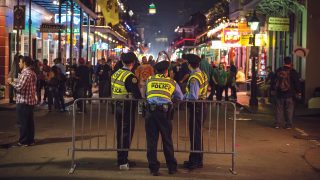
Traditionally, police departments have relied on sworn officers to maintain law and order within communities. However, police departments have increasingly turned to volunteers to fill unique and specialized roles. This continuing evolution reflects a collaborative effort between law enforcement and the communities they serve, fostering a sense of shared responsibility for public safety.
In 2002, then-President George W. Bush created USA Freedom Corps (USAFC) to build volunteerism following September 11. When he announced USAFC in his 2002 State of the Union address, he called on all Americans to serve a cause greater than themselves. Citizen Corps was created to help coordinate volunteer activities to make communities safer, stronger and better prepared to respond to any emergency. One of the partner programs that was created was Volunteers in Police Service (VIPS). This program is now coordinated by the International Association of Chiefs of Police (IACP), which provides free online resources on how to develop, structure and run a volunteer program (tinyurl.com/2ydkevvd).
Community engagement and outreach
Volunteerism in policing is a backbone that links back to Sir Robert Peel’s philosophy of policing.
“The police are the public, and the public are the police; the police being only members of the public who are paid to give full-time attention to duties, which are incumbent on every citizen in the interests of community welfare and existence.”
One of the primary ways police departments are utilizing volunteers is through community engagement and outreach programs. The VIPS structure provides a framework to build a program that fits the unique needs of each police agency’s needs.
VIPS often participates in Citizens on Patrol (COP) programs, doing vacation house checks or serving as additional eyes for patrol. They can be used at community events, crime prevention programs such as Operation ID, neighborhood watch and educational initiatives to bridge the gap between the police and residents. There is no one-size-fits-all volunteer program in policing. Each agency has different needs and resources and different political and crime environments, and thus, must tailor their volunteer program to the needs of their community.
Civilian patrols: Citizens on Patrol
Volunteer-driven civilian patrols have become a common sight in many communities. These patrols can be on foot or bicycle or in a vehicle, and function as additional eyes and ears for law enforcement. While they do not possess the same authority as sworn officers, they play a crucial role in deterring crime, reporting suspicious activities and providing a visible presence in neighborhoods. Agencies may have a COP program to check vacation house checks, park patrols, or help at festivals. This collaboration enhances the overall safety of the community.
Specialized skills and expertise
Some agencies have tapped into the expertise of volunteers with specialized skills. Professionals such as doctors or paramedics, lawyers, psychologists or IT specialists contribute their knowledge to assist law enforcement in various capacities. A doctor or paramedic can serve as a volunteer medical director to oversee training for Emergency Medical Responder (EMR) certification or in training staff in the application of Naloxone, tourniquets and the use of individual first-aid kits. Legal experts may provide guidance on community legal matters or support training classes, psychologists may assist in crisis intervention, and IT specialists may contribute to cybercrime prevention efforts.
Victim advocacy
A hugely underserved population is our crime victims. From a customer-service perspective, law enforcement has done a poor job of providing follow-up resources and contacts to crime victims. Such a program could be expanded to include volunteers
providing follow-up crime service information, connecting them with appropriate services and/or accompanying victims to court.
By involving volunteers in this capacity, police departments offer a more compassionate and comprehensive response to those affected by crime. The Office of Victims of Crime (OVC) in the Department of Justice provides resources that can be accessed to assist a volunteer police-based victim support program (tinyurl.com/yabm6d9j).
Youth engagement and mentorship
Recognizing the importance of positive interactions between law enforcement and young people, some police departments have established volunteer-driven youth engagement and mentorship programs. Volunteers work closely with young individuals, offering guidance, mentorship and educational support. These programs aim to foster positive relationships early on, reducing the likelihood of youth involvement in criminal activities.
For example, the Police Athletic League (PAL) dates back to 1914 with the Police Athletic League of New York City. Today, the National Police Athletic/Activities League (tinyurl.com/yjsm5s) is the one-stop-shop for learning about creating, operating and funding an athletic league.
CERT
The Community Emergency Response Teams (CERT) concept was developed and implemented by the Los Angeles City Fire Department in 1985. CERT became a national program in 1993. There are now CERT programs in all 50 states, each being unique to its community. There are over 2,700 local CERT programs nationwide, which have trained more than 600,000 people.
CERT empowers community members to become the first line of defense in the event of a disaster or emergency. Some colleges and university police departments utilize the CERT program to support large sporting events or other on-campus needs. These volunteers undergo training in basic disaster response skills,
including first aid, traffic control, fire safety, search and rescue techniques, and organizational
skills. By equipping civilians with these essential skills, police departments are not only enhancing the community’s overall resilience but also establishing a collaborative approach to emergency response.
Benefits
There are several reasons why law enforcement should leverage the use of volunteers. But, to emphasize, this is not without investing staff time, developing policies, focusing on specific program outcomes and providing structured training and necessary equipment.
- Community engagement and trust: Volunteers serve as a bridge between law enforcement and the community, fostering trust and understanding. Departments can break down barriers and create a more collaborative environment.
- Extended reach and visibility: Volunteers can enhance the visibility of law enforcement in the community, contributing to crime deterrence and reinforcing a sense of security.
- Cost-effective resource utilization: Volunteers provide a cost-effective way for police departments to expand their resources without ballooning budgets.
- Specialized skills and expertise: Many volunteers possess specialized skills or professional expertise that can be valuable to law enforcement. Integrating these skills enhances the department’s overall capabilities.
- Crime prevention and community policing: Volunteers can actively contribute to crime prevention efforts by participating in community policing initiatives that might not otherwise be possible for an agency to deliver.
- Increased visibility in diverse communities: Volunteers from diverse backgrounds can help law enforcement better connect with different segments of the community. This inclusivity is crucial for building positive relationships and ensuring that policing efforts are culturally sensitive and responsive.
- Support for emergency response: During emergencies or natural disasters, volunteers can play a vital role in supporting law enforcement efforts. Whether assisting with evacuations, providing first aid, or helping with logistics, volunteers enhance the department’s capacity to respond.
- Youth engagement and mentorship: Engaging volunteers in youth programs helps build positive relationships between the police and young people. This proactive approach can contribute to crime reduction by addressing the root causes of delinquency and fostering a sense of community responsibility.
- Public relations and positive image: Having volunteers actively involved in community-oriented activities generates positive publicity for police departments.
- Flexibility and adaptability: Volunteers provide a flexible and adaptable workforce. They can assist with various tasks based on their skills and availability, freeing up other police resources.
Conclusion
The utilization of volunteers in unique roles within police agencies marks a continuing shift towards more community-oriented and collaborative policing. There is an almost inexhaustible list of programs where volunteers can be used; the programs listed here merely touch the tip of the iceberg.
By re-evaluating agency needs, it may be time to update your volunteer programming for the future to continue to grow the relationship between police and the communities they serve.
As seen in the February 2024 issue of American Police Beat magazine.
Don’t miss out on another issue today! Click below:






